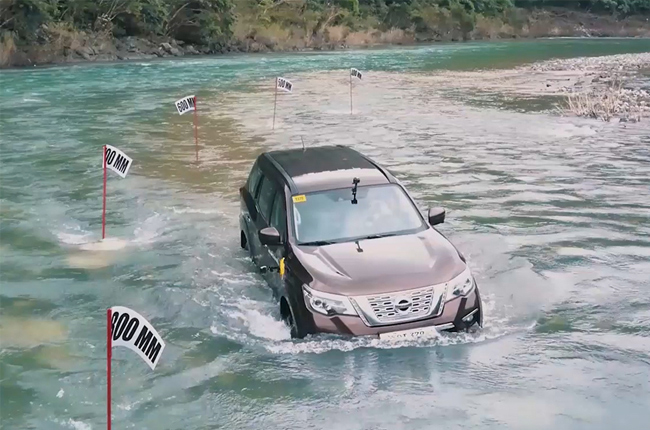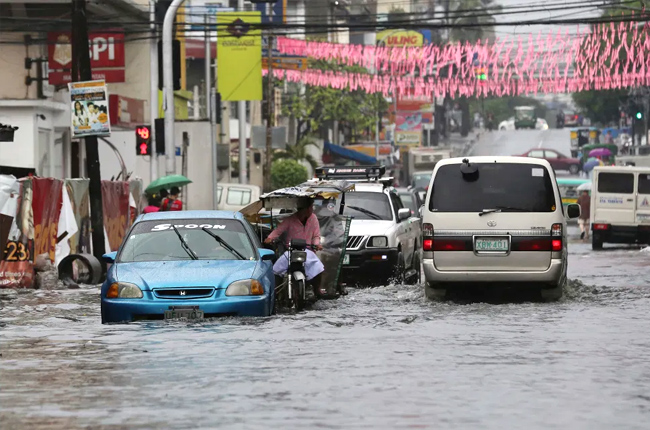
During heavy downpours, there is a high chance for flash floods to occur, especially in urban areas where the majority of water canals are not properly maintained. Given the high probability of floods in the Philippines especially during the rainy season, many buyers are considering crossovers, SUVs, and pickups with high wading depth, allowing them to cross through floods with more confidence.
While taking alternate routes does seem like a good idea, there are times that you just have no choice but to cross through the flood. Whether you have a small car or even high-riding vehicles that can cross, there are still some things you should take note of in order for you not to end up stalling your vehicle in the middle of a flood. That said, here are some ways on how you can safely drive your vehicle through a flood.
Check your vehicle’s water wading depth

High-riding vehicles like the Ford Everest, Ford Ranger, Nissan Terra, Nissan Navara, Mitsubishi Montero Sport, Mitsubishi Strada, and many others are more than capable of crossing through floods, as some of these models even have an 800 mm water wading depth. Floods are more concerning for smaller cars like sedans and hatchbacks, as these vehicles lack the ride height of those aforementioned models.
Proceed through the flood if you think your car’s wading depth can cover the amount of water, if not, then your last resort is to find an alternate route instead. You can even just stay at the corner and park until the flood subsides, otherwise, if that’s going to take long, then just cancel your plans and go home, you don’t want to risk your car from the possible urban floods.
Another tip is for you to plan ahead, if you happen to experience a heavy downpour outside of your house then it’s better not to leave unless you have the right vehicle that’s capable enough to cross through floods or a good enough reason to risk it.
Let oncoming vehicles pass through the water first

Before you proceed, check if there are oncoming vehicles. If there are, let them pass first especially if they are large vehicles or traveling fast as these vehicles could splash your vehicle.
Proceed and drive on the highest point of the road

This is one of the reasons why you should patiently wait for oncoming vehicles to pass through. During floods, most roads are deep on either side. There are some instances when it’s best for you to cross at the middle path of the road in order for your vehicle to travel through the water. Then again it still depends on the road you're on, as local highways and other wider roads have a pool during a storm, making it more ideal to settle on either corner of the road.
Watch your speed—Don’t drive too fast

5 to 6 km/h should be an ideal speed when crossing through a flood. Do not drive too fast, as you will be risking your tires from losing their grip on the road. Keep the pressure on your accelerator constant. Feather the throttle, but don’t floor it.
If your tires lose grip, don’t slam on the brakes, just gently lift your foot off the accelerator and keep your steering wheel straight until the grip returns.
Maintain proper momentum—Do not stop

Do not let your car come to a halt, as doing this could allow water to get into your car’s exhaust pipe, other mechanical components, and even your car’s interior, also, remember to keep the engine revs up. If you’re driving a manual, just be steady with the accelerator and keep a foot on the clutch pedal just in case you need to keep the engine from stalling. For automatic vehicles, select the lowest possible held gear and remember to keep your foot on the accelerator in order to maintain proper momentum.
Dry your brakes

After you’ve successfully crossed the horrendous flood, now, it’s time to dry your car’s brakes. In order to do this, first, find a safe place and then feather your car’s brakes a few times in order to ensure its responsiveness on the road. Do not slam your brakes, as you could cause a possible rear-end collision with the passenger behind you.

If you haven’t successfully gone across the water and your vehicle just stalled all of a sudden, don’t panic and just stay inside of your car and call for help. Remember, do not get out and open the hood as could worsen the damages your car has accumulated from the flood.
Latest Features
-
The difference between wax and polish / Tips & Advice
Confused about whether your car needs a wax or polish? This article will guide you on what they are and what to choose for your car.
-
The 6 things every Ford Ranger must pass before it leaves the factory / Featured Article
Every Ford Ranger, from the base model to the Ranger Raptor, goes through a full inspection process before it leaves the factory. This includes six steps that make sure it’s ready to drive a...
-
Which GAC AION EV is best for your everyday lifestyle? / Featured Article
The GAC AION lineup has something for everyone, maybe you're after space, speed, or just a smooth city drive. Here's a quick breakdown of which model might work best for your day-to-day life...
Popular Articles
-
Cheapest cars under P700,000 in the Philippines
Jerome Tresvalles · Sep 02, 2024
-
First car or next car, the Ford EcoSport is a tough package to beat
Jun 18, 2021
-
Car Maintenance checklist and guide – here’s everything you need to know
Earl Lee · Jan 12, 2021
-
Most fuel efficient family cars in the Philippines
Bryan Aaron Rivera · Nov 27, 2020
-
2021 Geely Okavango — Everything you need to know
Joey Deriquito · Nov 19, 2020
-
Family cars in the Philippines with the biggest trunks
Sep 20, 2023
-
Head to head: Toyota Rush vs. Suzuki XL7
Joey Deriquito · Oct 28, 2020
-
Why oil changes are important for your car
Earl Lee · Nov 10, 2020
-
2021 Kia Stonic — What you need to know about it
Joey Deriquito · Oct 16, 2020
-
Top 7 tips for buying a used car in the Philippines
Joey Deriquito · Nov 26, 2020



